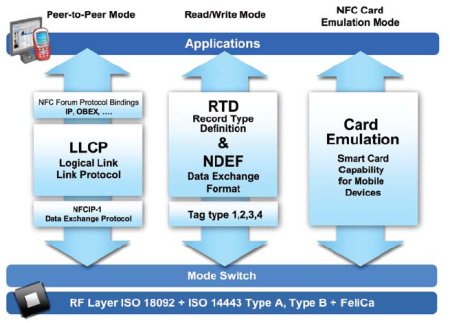Contactless NFC technology delayed, but coming
Jan 10, 2008 — by Eric Brown — from the LinuxDevices Archive — 7 views A contactless payment technology for mobile handsets called Near Field Communication (NFC) is coming to market slower than expected, says ABI Research. Yet while 2008 NFC shipment forecasts have been revised downward, the technology's future is said to be bright.
A contactless payment technology for mobile handsets called Near Field Communication (NFC) is coming to market slower than expected, says ABI Research. Yet while 2008 NFC shipment forecasts have been revised downward, the technology's future is said to be bright.
digg this story
In ABI's “Contactless Commerce Forecasts” study, its 2007 NFC shipment forecasts have dropped from 1.1 million to 0.65 million shipments, and 2008 projections from 9.81 million to 6.52 million.
Yet, ABI says its previous long-term forecasts for NFC remain unchanged, with 450 million NFC-enabled mobile phones expected to ship by 2011. This figure represents almost 30 percent of the global handset market. NFC's expected progress in contactless payments from smartcards and mobile handsets will be bolstered, says ABI, by inroads into single-use ticketing for public transportation.
The overall market for contactless transportation ticketing and payments grew 15 percent in 2007 to $200 million, said ABI, which projects an $820 million market by 2013. Contactless technologies include not only NFC, but also infrared, Bluetooth, and radio frequency ID (RFID). Yet, NFC is the emerging leader for mobile phones.
A separate ABI Research study on the NFC IC market released last week, “Near Field Communication Semiconductors,” said that market demand for NFC handset standards has delayed deployment, while strengthening long term prospects. The study projected that over 419 million NFC chipsets will ship in 2012, but revenue will be offset by declining unit ASPs (average selling prices). With ASPs dropping to $0.97 by 2012, total revenue will reach $406 million.
Inside NFC
NFC is an extension of the ISO 14443 standard for RFID-based proximity cards. It is designed to offer a more power-efficient and affordable alternative to Bluetooth for very short-range, low-bandwidth applications. NFC uses magnetic loop induction technology to transmit data over a few centimeters at up to 424Kbps using the unlicensed 13.56MHz band. There are both passive (one-way) and active (two-way) versions of the technology, the latter being similar to Bluetooth transfers.

NFC architecture (Source: NFC Forum)
(Click to enlarge)
Sony has found great success in the Japanese smartcard and handset market with a 13.56MHz band, ISO 14443-based technology called FeliCa that is similar to the passive version of NFC. FeliCa is built into Linux-based DoCoMo phones, such as the Panasonic p904i pictured at the top of the page. The DoCoMo phones run MontaVista Linux and the MOAP (Mobile Oriented Application Platform) phone stack. Sony recently released a FeliCa 2.0 version, developed with NXP Semiconductors, that is said to be compatible with NFC, and around the same time DoCoMo joined the NFC Forum industry group.
ABI says rollouts have begun in Europe, with all eyes on a deployment currently underway in the U.K. According to the NFC Forum, commercial roll outs are underway in Germany and Austria, and there are trials in London, Singapore, the Netherlands, Finland, and New York.
The ABI Research report, “Contactless Commerce Forecasts,” is available here, and the “Near Field Communication Semiconductors” report is available here.
This article was originally published on LinuxDevices.com and has been donated to the open source community by QuinStreet Inc. Please visit LinuxToday.com for up-to-date news and articles about Linux and open source.